Behind me I have 17 red light therapy panels. And what I'm going to be doing is comparing all of these panels across eight different categories to determine which one is the best red light therapy wall panel of 2024.
We're going to look at price, we're going to look at power, wavelengths, EMF, sound, operation, things I like, things I don't like.
You see, I've used and reviewed all of these panels individually. So, I know what's good about them, I know what's bad, I've been doing this for a long time, and I can't wait to share all my thoughts, all my feedback.
And be sure to stick around until the end of this blog because not only will I be announcing the winner, I will also be doing some special awards. That's because the perfect panel for me may be very different to the perfect panel for you.
Also, with code ALEX or similar you can get most of these panels:
- PlatinumLED BioMax: https://aferg.co/redled - a unique discount code is generated after you click the link
- Block Blue Light Powerpanel Mega: https://aferg.co/BlockBlueLight - code ALEX saves
- BonCharge Hive Max: https://aferg.co/blublox - code ALEX saves
- Rojo Refine: https://aferg.co/rojo-rlt - code ALEX saves
- Rouge G3: https://aferg.co/rougecare - code ALEX saves
- Mito Red Light MitoPRO 1500 X: https://aferg.co/7d221 - code ALEX5 saves
- Hooga Ultra 1500: https://aferg.co/hooga-rlt - code ALEX saves
- LightPath LED Shortie XL: https://aferg.co/lightpathled - code ALEX saves
- Mito Light Biohacker 4.0: https://aferg.co/mitolight - code ALEX saves
- Red Light Therapy Co Red Rush 840: https://aferg.co/redrush - code ALEX saves
- Idoo 1500: https://www.alibaba.com/ - no discount available
- Infraredi Pro Max: https://aferg.co/infraredi - code ALEX saves
- Scienlodic P1500: https://aferg.co/scienlodic - code ALEX saves
- GembaRed Overclocked: https://aferg.co/gembared - no discount available
- Kala Elite: https://aferg.co/Kala - discount code is generated after you click the link
- CytoLED Triplex: https://aferg.co/cytoled - code ALEX saves
- Joovv Solo 3.0: https://aferg.co/joovvbca0 - no discount available
- BonCharge Hive Max: https://aferg.co/blublox - code ALEX saves
Here's the full video of the best red light therapy panel 2024:
History: Older Versions Of Best Red Light Therapy Panel
For people who may want to look back to my earlier results, here's the 2019 version of my best red light therapy panel:
And, then, my 2021 version of the best red light therapy panel comparison:
Watch these versions if you want the previous results. For the 2024 version, check here:
2024 Best Red Light Therapy Panel. Round 1: Size
Ok, here, in round 1, I will be looking at LED count and the width. The width is the distance between the LEDs in the panel. Not the panel with but the LED with, because the more LEDs you're getting and the wider those LEDs are spaced out, the better the light coverage on the body. Which is what you want when you're buying a panel - a large treatment area.
All right, let's bring up the results of round 1:
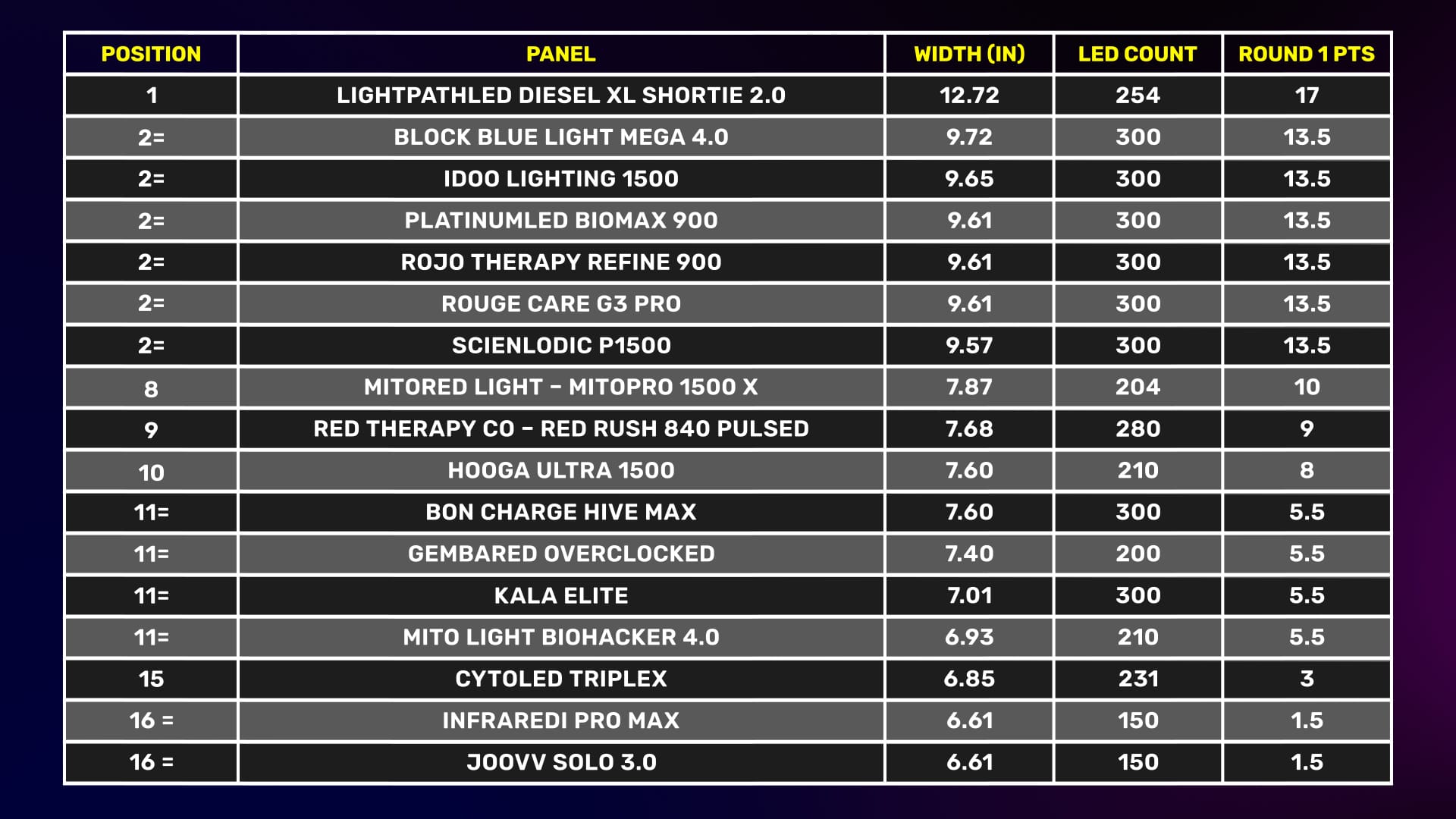
- In the last place, we've got the Infraredi Pro Max and the Joovv Solo. Now what's interesting is that Joovv has been around for a long time and so is Infraredi. Infraredi actually placed third in my last comparison series though I am excited to see how their new panel goes. Joovv on the other hand hasn't been updated - this is the same panel that was in that last series. But, they're after a bad start, the reason why is that both of these panels only have 150 LEDs plus they're quite narrow - they're only 6.61 inches across
- In 15th place we've got the CytoLED Triplex. Now this panel was also used in my last comparison series. 210 LEDs and just under 7 inches across.
- Then we have four panels that came in at 11th place equal. These panels range from 200-230 LEDs and were all about 7-7.5 inches across. These panels are the Mitolight Biohacker 4.0 - this is a new panel from a company in Europe and a lot of people have said good things about it so it's to see how it plays out. Kala Elite: this is a Canadian company and I'm excited to have this panel in my series. Then there's the GembaRed Overclocked - this is the latest panel from Gembared, and this company was also featured in my series before. And the Boncharge Hive Max - this is an Australian company and this particular panel was also in my last series.
- In 10th place, we have the Hooga Ultra 1500. This is a brand new panel, 300 LEDs, which is great, however it's only seven inches across.
- In 9th place we have the Red Therapy Co Red Rush 840 pulsed. 280 LEDs, just under eight inches across.
- In 8th place we have the Mito Red MitoPRO 1500 X. Now Mito Red light actually placed first in my last comparison series. The 1500 X is their new generation panel - just released, just in time for this series. I'm really excited to see if they can defend their position - they're not off to the greatest start with an 8th place. The panel has 300 LEDs but they're let down by the width, they're only 7.6 inches across.
- Now we have six panels in 2nd equal. All of these panels have 300 LEDs and they all were over 9.5 inches across. These are typically what I refer to as "12-inch panels" because it's 12 inches from the outside of the panel but you're only getting about 9 inches of light coverage. But they're all doing really, really well - so from the bottom up: the Scienlodic P1500, a Chinese company shipping internationally. Then we have the Rouge Care G3 Pro, this is Rouge's new panel that I reviewed in 2023. Then we have the Rojo Therapy Refine 900. This panel is just being released - an Australian company shipping internationally. It's only their second-generation panel because the company has only been running for a year. The panel looks really, really good, it could do well in this series. Then we have the PlatinumLED BioMax 900. Now this is a panel that has been around for a long time and it is always doing well in reviews and comparisons. The panel won my first comparison series in 2019. In the last comparison, I used the smaller BioMax 600 and it placed a very close second. It's going to be interesting to see how the 900 does in this series. The final two in second place were the Idoo Lighting 1500. This is actually an Alibaba Chinese company - I purchased it directly though Alibaba. I've done a review on that panel, really good, great price. And then the final company was Block Blue Light Mega 4th Generation. Now this is another new company to my red light therapy series. The 4th gen panel is just being released late 2023 - looks really great on paper, I mean it's off to a great start here. So this is another company to watch.
- So that leaves us in first place, with the LightpathLED Diesel Shortie XL 2.0. Now this panel only had 254 LEDs and it's a little bit less than the second place panels. But the panel was super wide with 12.72 inches across. And that's why it came out number 1. That extra width means that you will get a really wide coverage of light. Sure, it's not going to treat the full body but it's going to hit from nipple to nipple, or shoulder to shoulder, depending on your size.
- So that's the result of the first round!
Round 2: Power
Okay, so now in this round we're looking at power output. I've measured these numbers using my spectrometer. I take 9 different readings and take an average at 6 inches - it gives me a pretty accurate way how much light - how much therapeutic red light - is being emitted from a panel.
The more power, the more light energy going into the body but also the deeper it's going to penetrate. Some people won't like this but you can stand further away from a panel to reduce the energy hitting the body. And a lot of panels have the ability to regulate and reduce the intensity as well.
So, for those reasons, I simply rank the panels that are putting out the most energy at the top and the weaker ones at the bottom:
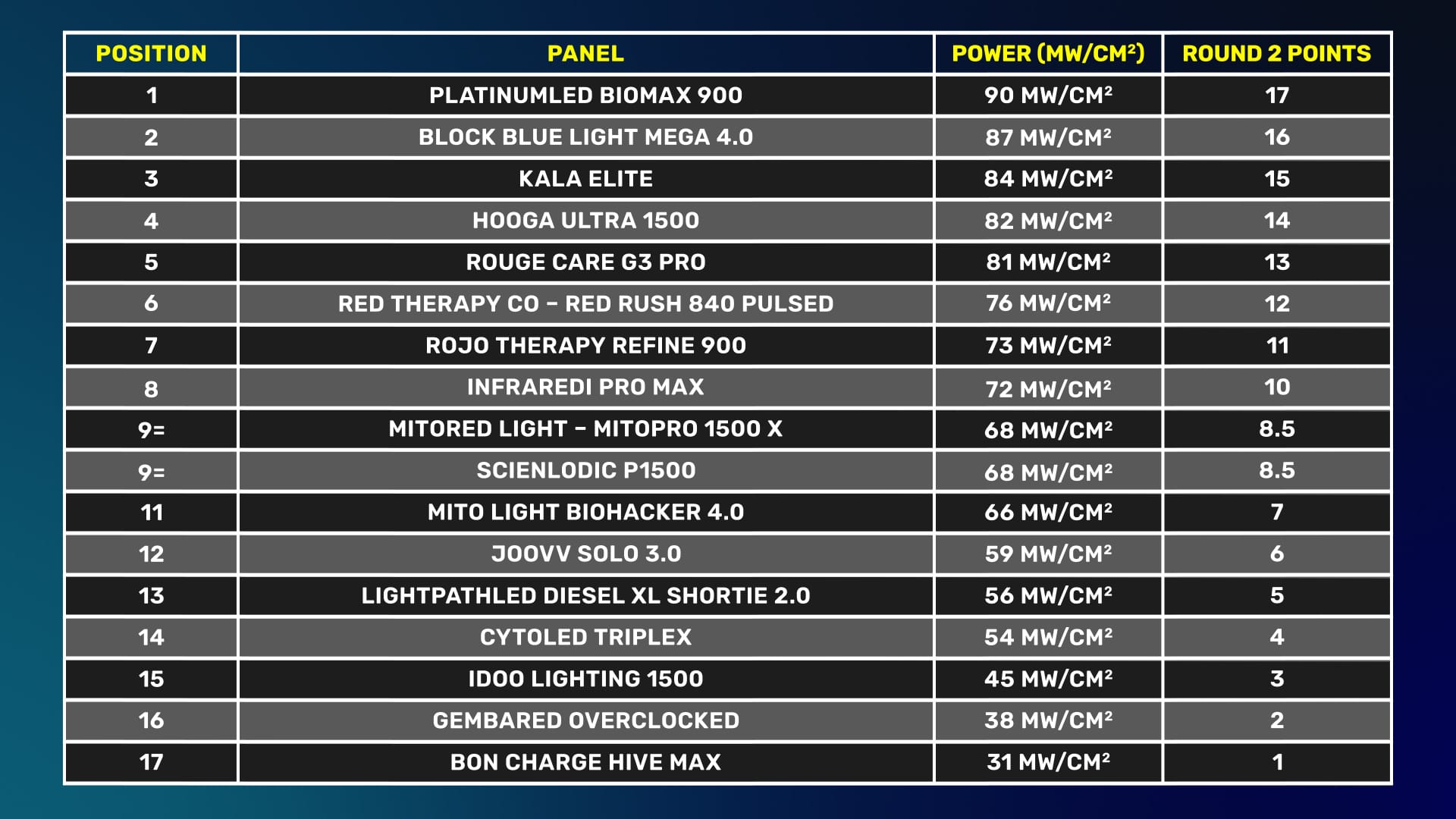
- In 17th place we have the Boncharge Hive Max at 31 mW/cm2.
- In 16th place GembaRed Overclocked with 38 mW/cm2.
- In 15th place the Alibaba panel at 45 mW/cm2.
- In 14th was the CytoLED Triplex with 45 mW/cm2.
- In 13th place was the LightpathLED Diesel with 56 mW/cm2.
- The Joovv Solo came in at 12th place with 59 mW/cm2.
- The Mito Light Biohacker 4.0 - 66 mW/cm2 at 11th.
- At 9th place equal were two panels: The Scienlodic P1500 and the Mito Red Light MitoPRO X. Both of them had 68 mW/cm2.
- Ok let's do the remaining eight. So in 8th place we have the Infraredi Pro Max at 72 mW/cm2. These numbers are getting up there - these numbers are decent figures, I mean, it's comparable to the top-3 rankings in my last comparison (of 2021). And now we're only in 8th place.
- In 7th place the Rojo Therapy Refine 900.
- In 6th place the Red Therapy Co Red Rush at 76 mW/cm2.
- And in 5th place the Rouge Care G3 Pro with 81 mW/cm2.
- In 4th place the Hooga Ultra 1500 at 82 mW/cm. That leaves the final three.
- In 3rd place we've got the Kala Elite at 84 mW/cm2.
- And in 2nd place we have the new Block Blue Light Mega 4.0 with a whopping 87 mW/cm2.
- That leaves us with the first place, the PlatinumLED BioMax 900. Now this is their 8th generation 2024 edition, with a crazy 90 mW/cm2 at 6 inches. So if you want a panel with plenty of power then look at that table above. Anything over 80 mW/cm2 is exceptionally high and you've got a bunch of options.
So now that we've got the points for round 2, we can add them all together and we can do our overall standings after two rounds:
Round 2: Scoreboard
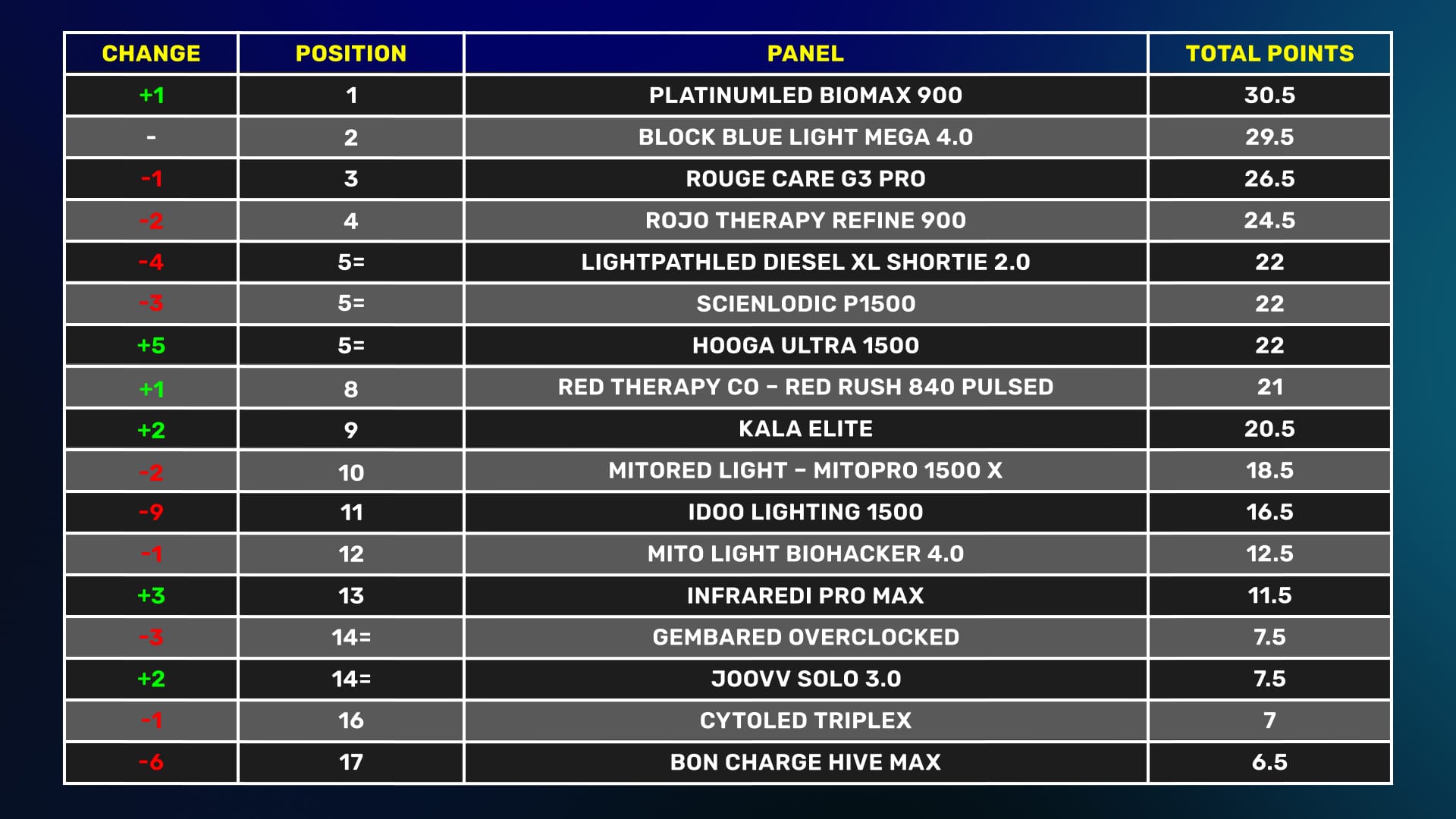
So what's interesting here is that PlatinumLED has moved to the top of the table with 30.5 points. Right behind them remaining in 2nd place is the Block Blue Light Mega - only 1 point behind.
Rouge Care in 3rd place, Rojo Therapy in 4th, and LightpathLED has dropped down four positions into 5th equal.
Looking at the defending champ (Mito Red Light), they dropped down two places and are 10th now.
Round 3: Wavelengths
So with round 3, my goal here is to reward a panel that is putting out a wide range of therapeutic wavelengths and also emitting that light in a nice, blended - a nice balanced way!
So I actually break down this round into 5 scoring parts:
- I look at how many wavelengths a panel is emitting. The more wavelengths, the better.
- I look at whether a panel has 810nm near-infrared light. Because I personally really like that and think there is a lot of research behind 810nm light and I think it's a game-changer when it comes to red light therapy. So if a panel has 810nm in it, it's getting a point.
- Next up, I look at whether a panel has multi-chip lenses. Now, earlier I wrote about LED count. Technically here I'm looking at the LED lens that you see but when you dive deeper into the LED there will be a chip in there. Traditionally panels used single-chip LEDs and we still see that with some panels today but now we're seeing companies that are squeezing multiple chips in there: two, three, even four chips. What this means is you're going to get a much blend of light coming the panel. Now, it's somewhat controversial because with the power these panels are putting out you can actually stand away further from the panel and that light is going to blend naturally. Though, I wanted to reward panels that are using multi-chip technology.
- I'm also looking at whether a panel has any unique wavelengths - wavelengths that we haven't seen in panels before - they get points if they do.
- And finally I'm looking at the blend of light - how the power in the panel is spread across the wavelengths. If 98% of the energy is going to one wavelength and the remaining 2% is split between four wavelengths, it may look good on paper but realistically it's not going to be great. So we'll reward panels that have a nice blend of light here.
So knowing all of that, here is the outcome of this round:
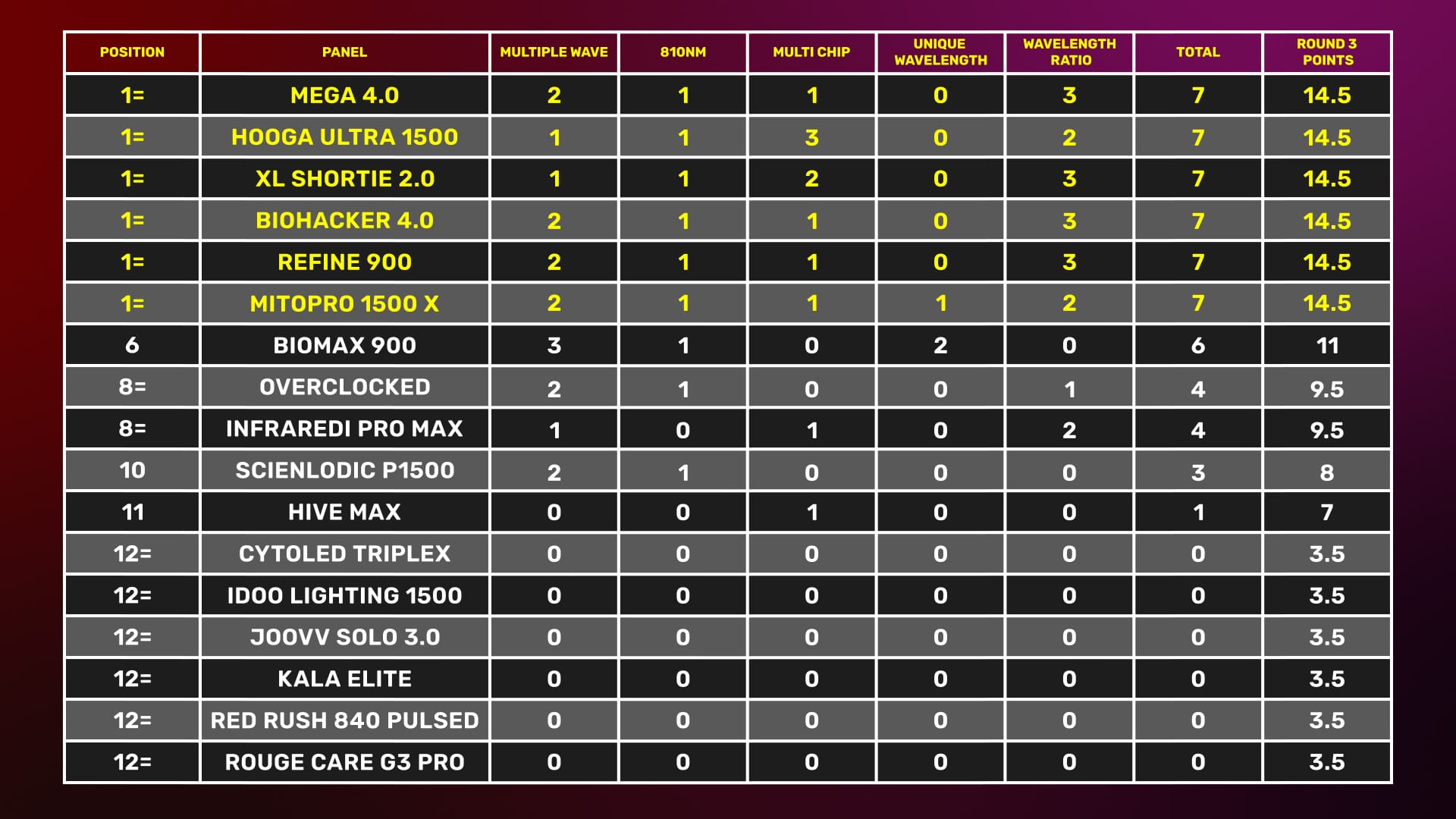
- In last place, which worked out to be 12th equal, we've got six panels. All of these panels get 3.5 series points. The reason these are placed last is because they're only emitting 660nm and 850nm light. There's nothing special going on here. They're just, as you could call them, old-school red light therapy panels. Now it's important to note that these panels aren't bad - you're still going to get a therapeutic dose of light. It's just that there are panels out there now that are better. A lot has improved but a couple of years ago these panels are all that you could get. But if you've got one of these panels or will get one of these panels for any reason, don't think you're buying a letdown because that's not the case.
- When we move up to 11th place, we see the Bon Charge Hive Max. This panel has dual-chip LEDs so it gets a point there.
- In 10th place we have the Scienlodic P1500. This panel has a couple of wavelengths in it.
- Now we're up to 8th equal. Here we have the GembaRed Overclocked and the Infraredi Pro Max. The GembaRed Overclocked is putting out a bunch of wavelengths, 810nm, and a good blend of light. The Infraredi Pro Max, on the other hand, doesn't have as many wavelengths but it is dual-chip and has a good blend of light.
- Ok, so in 6th place, we have the PlatinumLED BioMax 900. Now this is quite a unique panel - it has seven different wavelengths, so it's getting three points here, it does have 810nm light, so it's getting a point for that round - but it doesn't have multi-chip lenses - it's still using the older single-chip lenses. PlatinumLED say this topic doesn't really matter - it's such a high-powered device that if you stand 12 inches from the panel you're going to get a good blend of light. So it's not getting a point. However, the BioMax 900 does have two unique unique wavelengths - it's got blue light in there which is great for skin health and acne, and it also has 1,060nm near infrared light. We've been looking into this and it's quite an exciting wavelength. But yeah, no other panel has these two wavelengths so it's picking up two points here. Finally, the panel doesn't get any points in the wavelengths ratio section - this is because the majority of the power in the BioMax 900 is going to the 660nm and 850nm light - the two more traditional wavelengths. So yes there are five other wavelengths in the panel but they're not getting a heap of energy catered to these wavelengths. This is a big reason why it came in at 6th place but because it does have so many wavelengths and 810nm it did do better than a lot of the competitors.
- So that leaves us with six panels who ended up in 1st place for this round. The Block Blue Light Mega 4.0, the Hooga Ultra 1500, LightpathLED Diesel XL, Mito Light Biohacker 4.0, Rojo Therapy Refine 900, and Mito Red Light MitoPRO 1500 X. Now what's interesting here is that all of these panels use 810nm light, they all use multi-chip technology, and they also have a nice blend of power going to all their wavelengths. There are some unique differences between these panels. Block Blue Light, Mito Light, Rojo, and Mito Red Light all have at least five wavelengths, whereas Hooga and LightpathLED don't. Another big difference is in the multi-chip section - now all the five panels that all have five wavelengths are only using dual-chip lenses whereas the LightpathLED Diesel actually uses triple-chip lenses and the Hooga Ultra 1500 has quadruple chip lenses which is quite extraordinary. Then, when we look at the unique segment, we see that Mito Red light picked up a point here, this is because the new MitoPRO 1500 X actually uses 590nm light. This was quite a surprising addition, however, we have been looking through the research and it is a very credible and exciting wavelength. So Mito Red picked up a point here!
Ok, so now that we have the points for this round, let's add them to the table and see how the panels are doing overall:
Round 3: Scoreboard
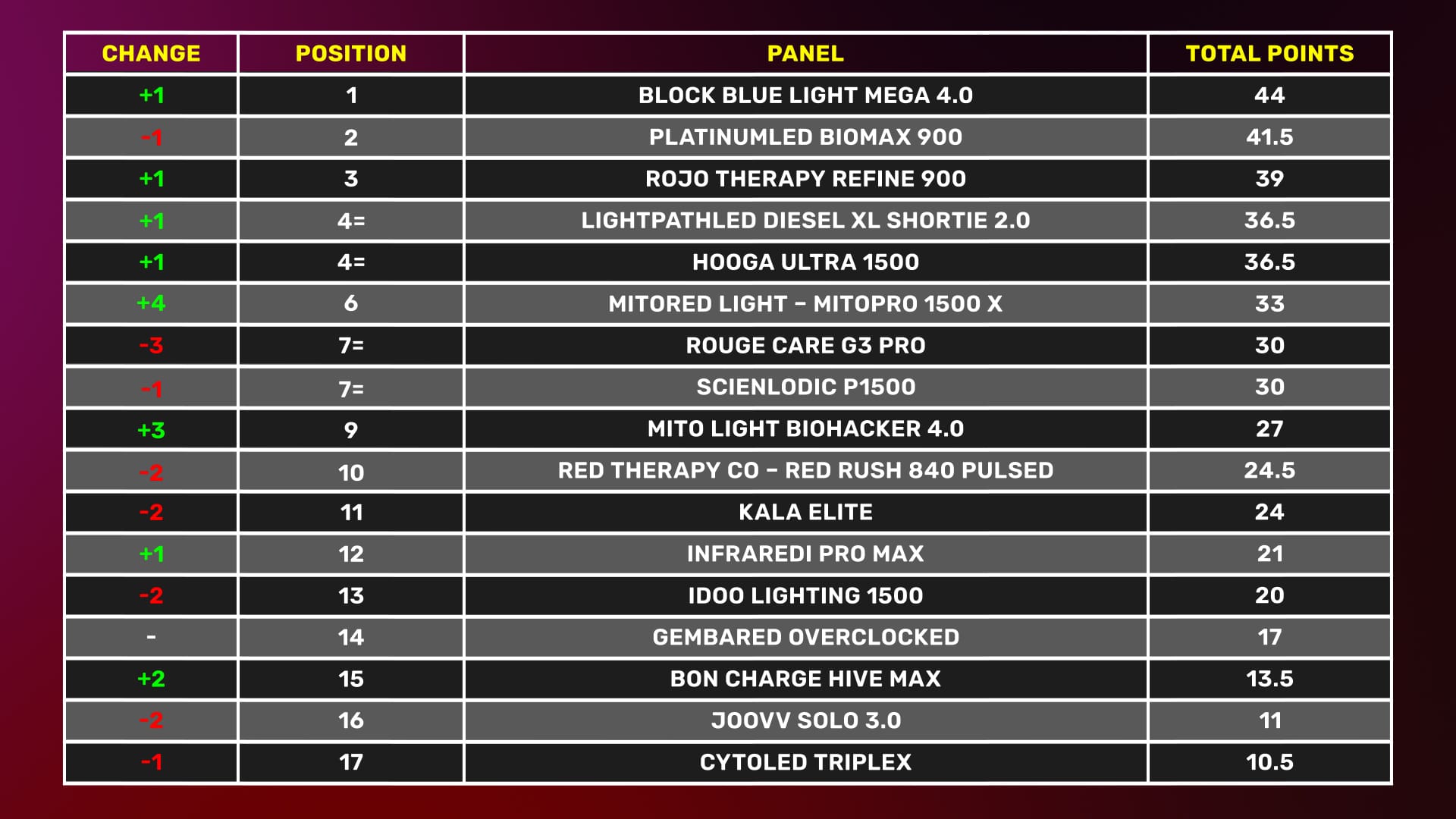
So what's interesting is that Block Blue Light is back in the top spot and PlatinumLED have dropped down to second spot. So it's still very close, even in the top-3 there's only a couple of points between them and we're only halfway through the series.
Rojo Therapy are up one to third place. LightpathLED and Hooga are fourth equal and up one. The Rouge Care has dropped down a couple of places because they're only using 660 and 850nm light. Mito Red Light MitoPRO is up four and the Mito Light Biohacker is up three. When we get all the way to the bottom, we see Joovv is slipped down to 16th place and CytoLED is on last place.
Round 4: Company
Round 4 we're looking at the company behind the panel. Now the reason I've included this round is because red light therapy is exploding. There are so many companies starting up, there are so many panels on the market, it's hard for me to keep up, but, there's also a lot of cowboys out there.
I mean it's very easy to start up a red light therapy company. And you can even begin without ever touching a panel. So the idea behind this round is to reward a panel that has a good company backing it.
Here I'm looking at four things:
- Warranty length
- Support options. Do they have a phone number? Can you pick up the phone and ring them? Next up:
- Time in business.
- Independent data. Are they sending the panel off for independent testing and are they sharing that data? Some companies are using solar meters to test their panels but you cannot trust that data. Solar meters are giving a much higher power output because that looks better in the marketing material. If you are shopping around, cross check the company's numbers with my data in my review or head over to Light Therapy Insiders and check out the shopping tool. You can see all the panels I've reviewed and the power output on there.
So let's look at the results here:
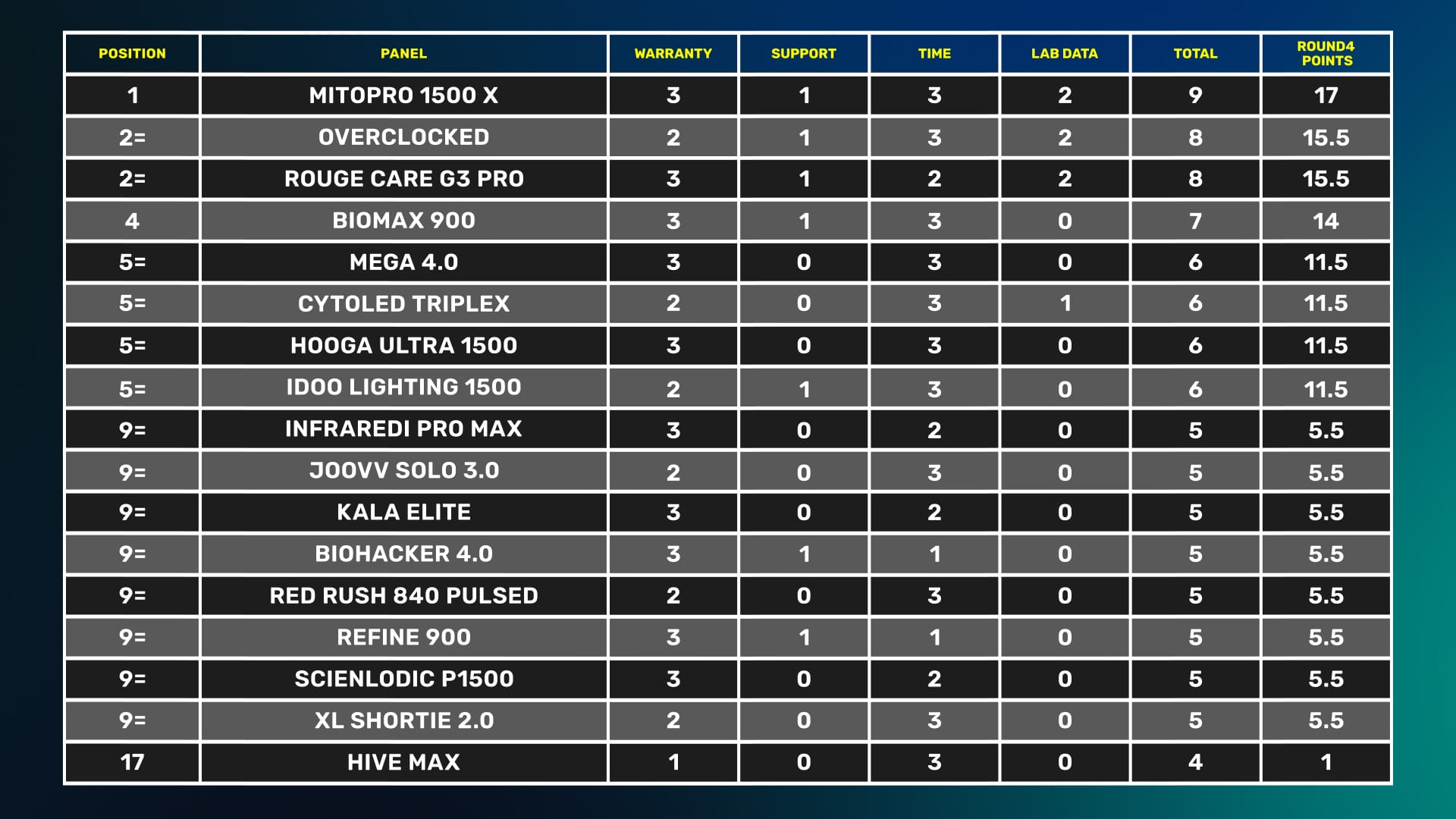
- In last place, we have the BonCharge Hive Max - they only offer a 1-year warranty thought they have been around for quite some time, which is good.
- Then we have eight companies in 9th equal place. Now, I'm not going through all the data here, you can read the table above. Pretty much with all these companies you're getting at least 2 years warranty, some of them are doing 3. Two of the companies, Mito Light and Rojo Therapy have support options which is great. And there's a wide range of how long these companies have been around - what's funny is that two companies that have phone support, Mito Light and Rojo Therapy, they're both really new companies, they've only been in the space for a year or two. Unfortunately, none of these companies are sharing independent data.
- Then we move up to 5th place. Block Blue Light, CytoLED, Hooga, and Idoo. All of these companies have been around for a long time and all of them offer good warranty periods.
- Now in 4th place, we have the BioMax 900 - they have a 3-year warranty, they have a phone number you can call for support, and they have been in business for a very long time - in fact, they're one of the original companies when it comes to red light therapy panels. And, their panels are featured in all of my comparison series. Unfortunately at the time of filming, they don't have any published lab data. However, I do know that they are working on something big in this area. I wish I could share more details and I wish that at the time of filming had their new lab data standard in place because it is going to be amazing for the industry. But, at the time of filming, I don't have any of this data so they get 7 points here.
- In 2nd place, we've got GembaRed and Rouge. Now, both these companies have sent off their panels for independent testing. And they share their data. And both companies have been around for a few years and they offer support options as well.
- So in 1st place, that leads to the Mito Red MitoPRO 1500 X. Now this company is offering a 3-year warranty, they've also got a phone number you can contact. They've also been in the space for quite some time, featuring in all my comparison series. And, if you go to their product website, you can see a direct link for their lab data. So that means Mito Red get full points for this round and hence come out on top.
Round 4 Scoreboard
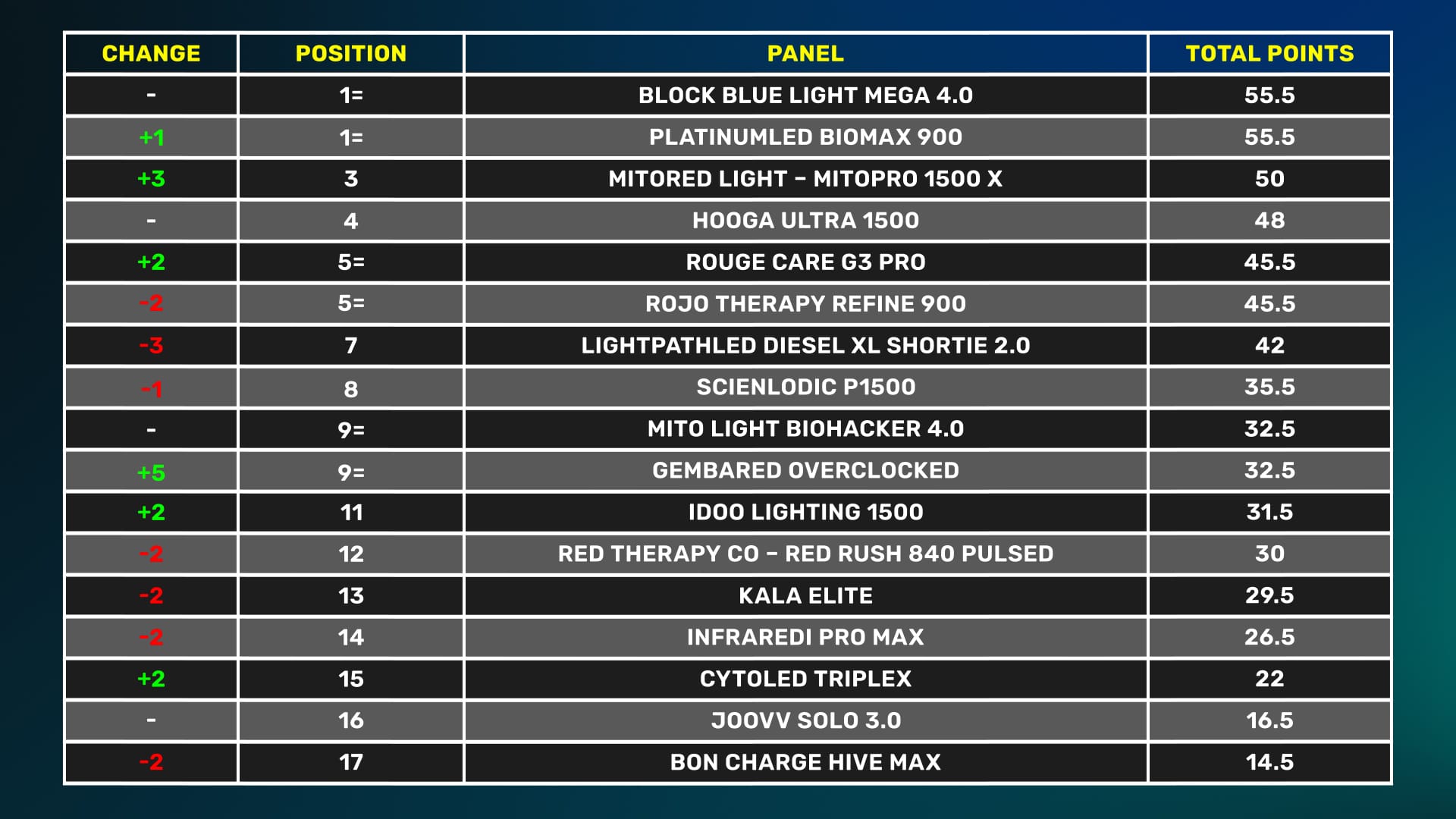
- Ok so what's interesting is that Block Blue Light and PlatinumLED are neck on neck in 1st place after four rounds - so there is a really good battle emerging here. I'm excited to see how it plays out.
- And by winning this round, Mito Round have jumped up three positions into 3rd place. They're only trailing the leaders by 5.5 points, so it is a good push here by the defending champions. Will they go back into top spot? We will see.
- Rojo Therapy has slipped two places into 5th equal sharing that spot with Rouge Care - who did perform well in this round.
- If we look at other noticeable changes, LigthpathLED are down three into 7th place, GembaRed are up five into 9th equal.
- Near the bottom we have a few position changes with BonCharge Hive Max in last place.
All right, there's three more rounds to go, so let's keep moving:
Round 5: Operation
Round 5 is what I title "operation". This is looking at ease of use, setup, what's it like to operate,
The key things I'm looking for here are:
- Modular support. Can you get more panels and clip them together? And also, can you control multiple panels from one source?
- I'm looking at whether it comes with a remote control. And whether it comes with an app.
- Whether there's a touch screen control system.
- I'm also looking at pulsing and dimming. The ability to reduce the power output.
- And finally I'm looking at stand options - not just are there stands out there but how many options there are. Because some people might want their panels mounted on a wall or they may want them on a vertical stand on wheels. Other people might want a horizontal motorized stand.
So, these are the things I'm looking at, let's go through the score:
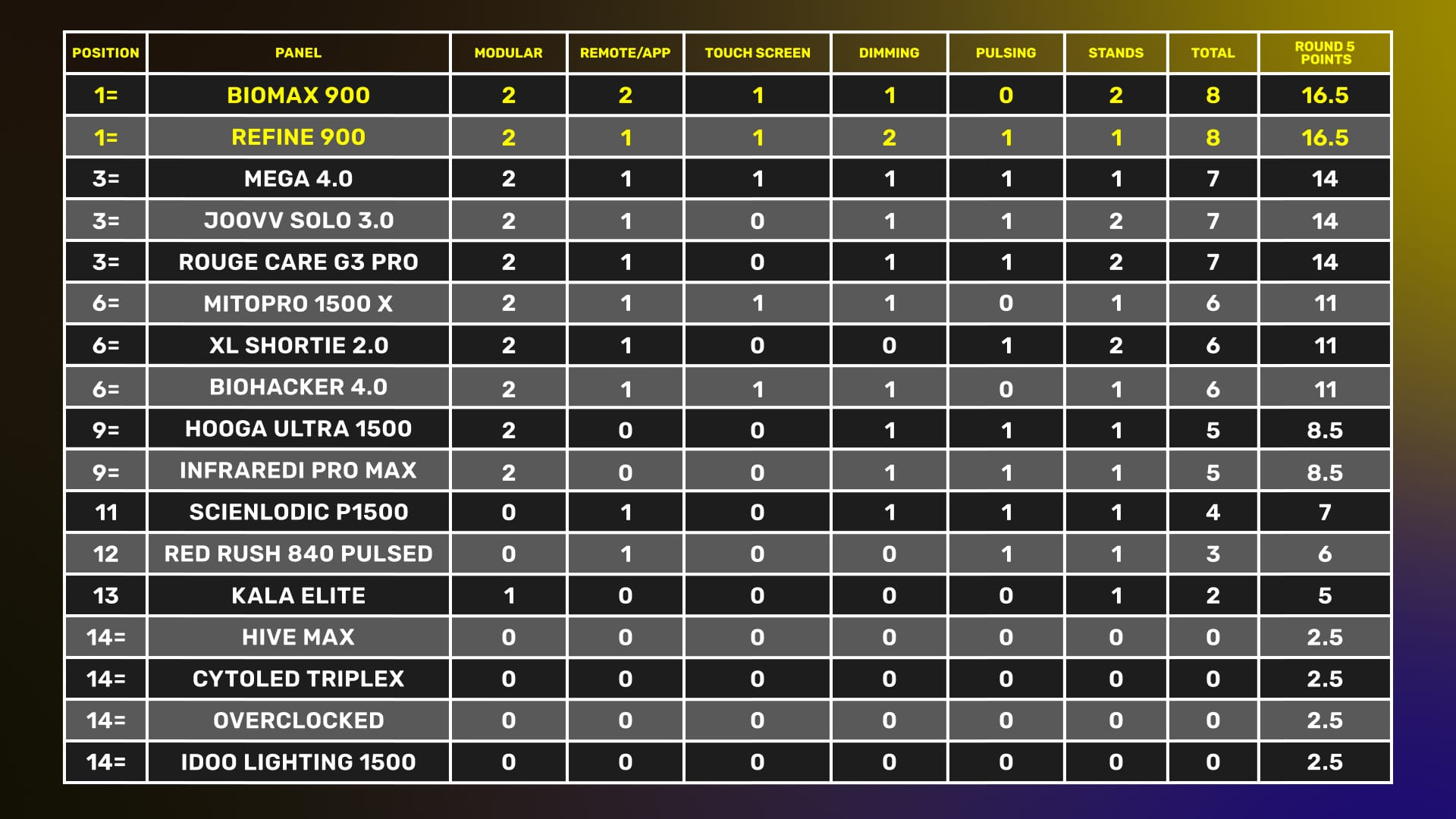
- So we've got four panels coming in at 14th equal, which is last place - Boncharge, CytoLED, GembaRed and the Alibaba panel. Unfortunately these panels don't have modular support, don't have the remote, don't have anything. Hence why they're rock-bottom last.
- Kala comes in at 13th place because it has modular support and some stand options. Moving up we have Red Therapy Co and Scienlodic.
- Then let's move up to 6th place. Here we have three options, the Mito Red MitoPRO X, the LightpathLED Diesel Shortie, and Biohacker 4.0. These have full modular support options. The Diesel comes with a remote control and the MitoPRO comes with an app. The MitoPRO has a touch screen and dimming but the LightpathLED has pulsing and better stand options.
- Now in 3rd equal we have Block Blue Light Mega, the Joovv Solo 3.0 and the Rouge Care G3. All have modular options, they either have a remote control or an app, and only the Block Blue Light panel has the touch screen which I personally like. They all offer dimming and pulsing functions and they all have good stand options.
- So that leaves two panels in 1st place. The PlatinumLED 900 and the Rojo Therapy Refine 900. So you're getting great modular support here which is nice. When connecting multiple panels they connect wirelessly. The BioMax comes with a remote, the Rojo doesn't. Both of them have an application which just mimics what you're doing on the touchscreen. What's quite unique here is that the Rojo allows you to dim individual wavelengths. Rather than just dimming the red or all the near infrared light, you can say, "I want to dim 850nm near infrared light but I want to leave 810nm at 100% and 850 at 30 or 40%. No other panel can do that, that's why I gave them an extra point there for the dimming. And the Rojo Therapy offers pulsing while Platinum doesn't. But Platinum has the best range of stands out of any companies. I think they have four or five different stand options just for the BioMax 900
But let's have a look at the overall standings then:
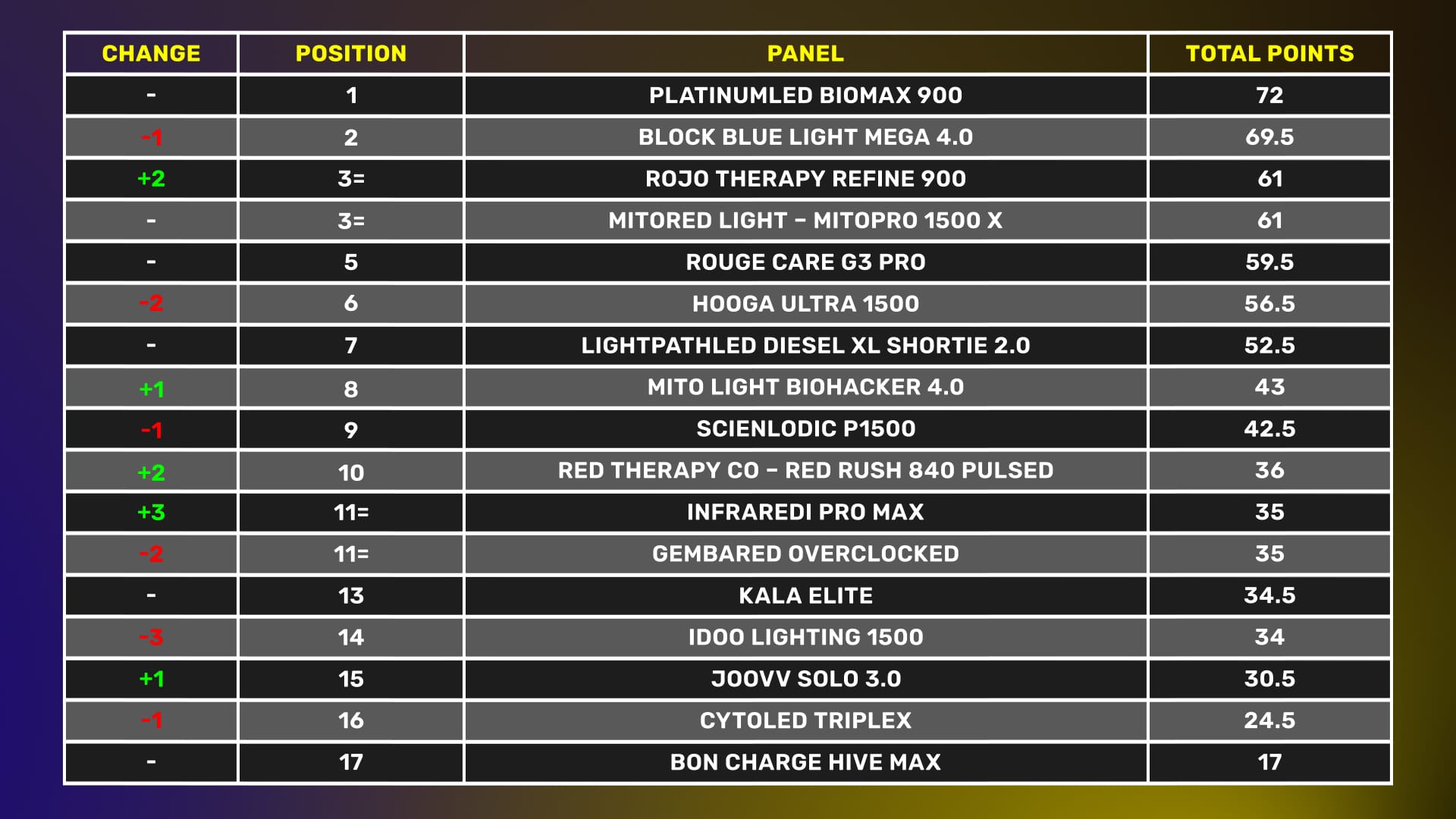
And as you can see, the PlatinumLED BioMax is on it's own in the first place.
Block Blue Light dropped a few points there to fall into 2nd place. Rojo Therapy shares third place with the Mito Red panel. This is very interesting, some big names in there - PlatinumLED and the Mito Red - and in between them we've got the two newcomers.
We have Rouge at 5th. Hooga have dropped two places to sit in 6th place.
And other big changes were the Infraredi Pro Max going up three to sit at 11th equal. And the Alibaba panel has dropped three places to fall down to 14th place.
So with two rounds left it is still open to anyone. You have to imagine that PlatinumLED and Block Blue Light are going to be in the top three and they have a decent buffer but there are still a lot of points up for grabs.
And then when you look at third position, well, two panels neck and neck, and then you have the Rouge Care panel only a few points behind, exciting times, let's go into the next round, huh?
Round 6: Extras
This round we're looking at whether a panel comes with a good-quality manual. I do this because if you're buying a red light therapy device for the first time, you want to know a bit about it - not just the panel but how red light therapy works, how long you should use it for, what the buttons do, and so forth.
So the manual is key.
I'm also looking at cable length, I'm looking at whether the panel has built-in grips that makes moving it a lot easier. I look at whether the panel comes with included eye-wear protection, I look at whether it's a low-EMF rated panel, I also look at the sound output because there's nothing worse than using a red light therapy with noise - it drives you nuts. Trust me, there are some panels out there that I would personally can't use - I hate it, it's just not enjoyable.
Then I look at any unique features or any negative features. So I spent a lot of time doing all this testing, totalled all the scores up - let's have a look:
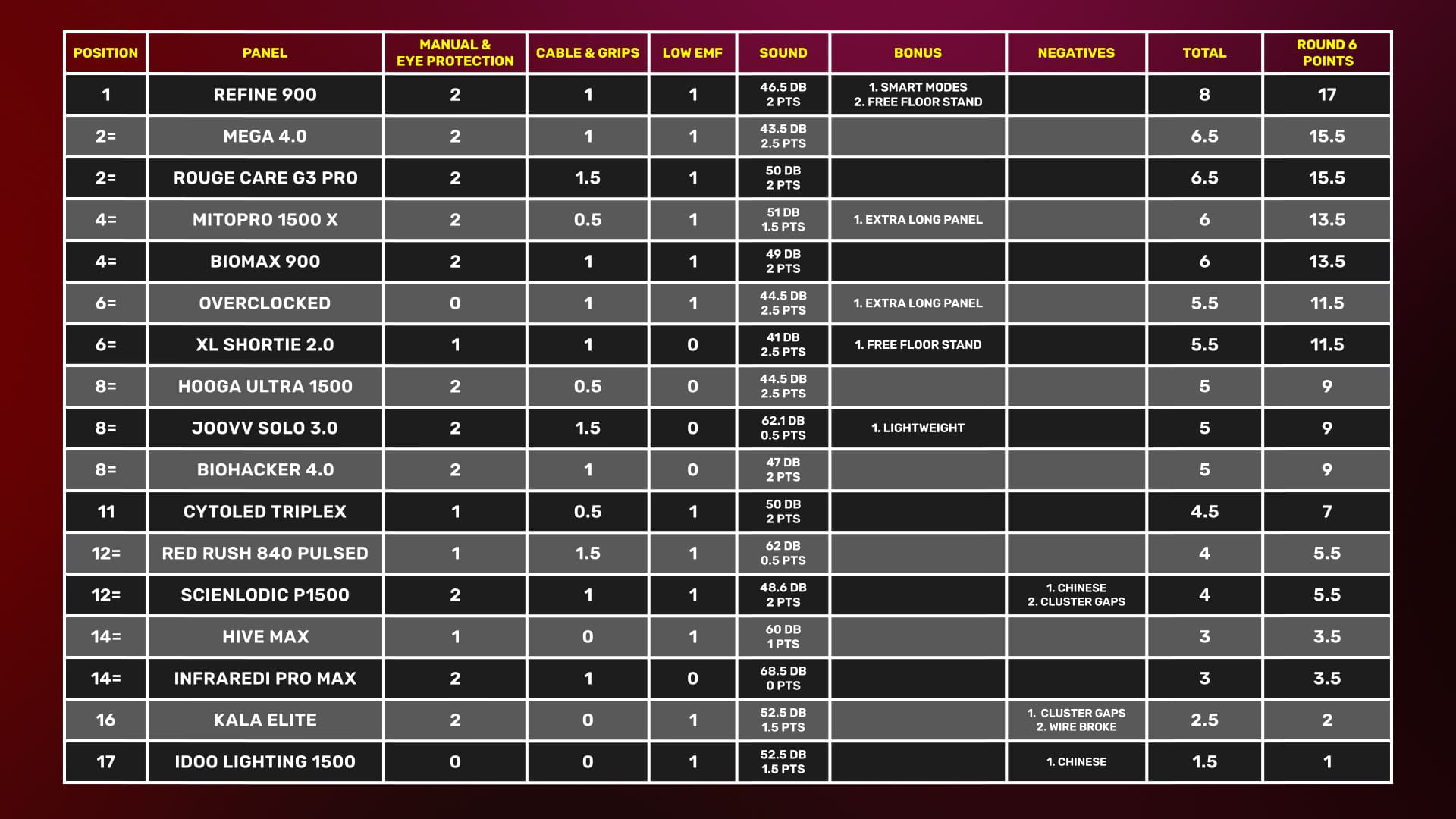
- In the last place we have the Alibaba panel. Pretty much they don't really tick any of the boxes. Plus this company is based in China - you're literally dealing with a Chinese factory so they lost the mark there.
- 16th place was the Kala Elite - has a good manual, low on EMF, a really short cable though, and it loses two points. Firstly, the LEDs are in clusters so you actually get a blank space between LEDs which is not great for light coverage. And secondly, the wire hooks I was using snapped.
- 14th equal we have the Infraredi Pro Max and the Bon Charge Hive Max. I'm not going into all the details here unless there is something really worth mentioning. You can check out the full table above. You can also compare products on our Light Therapy Insiders shopping tool that contains a lot more information than this blog post.
- In 12th place we had the Red Therapy Co Red Rush and the Scienlodic P1500. The Scienlodic P1500 wasn't too bad but it lost 2 points because, again, it's a Chinese company and it's got the cluster issues.
- 11th place: CytoLED Triplex and at 8th place equal we have the Joovv, Hooga, and the Mito Light Biohacker. One positive that the Joovv has is that it's ultra-lightweight, their panel - the panel is actually made of plastic. Trust me, when you're setting all these panels up, you pick up the Joovv and you nearly throw it into the ceiling. A light panel that's a big plus.
- In 6th place we have the GembaRed Overclocked and the LightpathLED Diesel Shortie. Now both of these had a really long cable and both are ultra quiet - two of the quietest panels I've tested. But, they don't come with printed quality manuals and they don't have built-in grips. The upside, though, is the Gembared panel is really is a really tall panel so I gave it a bonus point there. And the LightpathLED comes with a free floor stand so it gets a bonus point.
- In 4th equal we had Mito Red and the BioMax, coming in at equal points again. So, great manual, built-in grips, eye protection, low EMF, decent sound output. The PlatinumLED BioMax panel is really long but the Mito Red Light panel is really, really tall - the panel itself. Now in the first round, we rewarded width but I do want to give these bonus points - the GembaRed and the Mito Red Light for their height. Some people may which is really tall, so they get a bonus point there.
- In 2nd equal we have the Block Blue Light Mega and the Rouge Care G3. Great manual, great cable length, eye protection, low EMF, and really good on the sound front.
- And in the 1st place, we've got the newcomer, Rojo Therapy Refine 900. Now there's a few things to talk about here so let's run through it. Good cable length, built in grips, eyewear protection, good manual, low EMF, nice and quiet, but, it gets two bonus points. Firstly, it comes bundled with a free stand which typically sells for $100-130 odd dollars, so that's included in the price which is really good.
- And secondly, this Rojo panel is quite unique - you'll have to see my full review of that panel so subscribe to my YouTube channel to see that when it's out. But, the Rojo has built-in smart dosing mode. So you can go through the panel and, say, look, I want to focus on bone health, or muscle recovery, or skin health. You activate that, and the intensities, the wavelengths all change and it comes up with a session duration. No other panel does this. I actually think it's an absolute game-changer, it's amazing for people that are new to red light therapy - to be honest it's amazing for everyone. There are downsides with it though: how accurate are the dosing protocols? I mean, I haven't put out dosing protocols beause I cannot wrap my head around it! But still, I think it's a step in the right direction.
So because of that and all the other good things that come included with the panel, I think it's only fair that Rojo comes out number one. So that's another round done, let's go over and update the table:
Round 6 Scoreboard
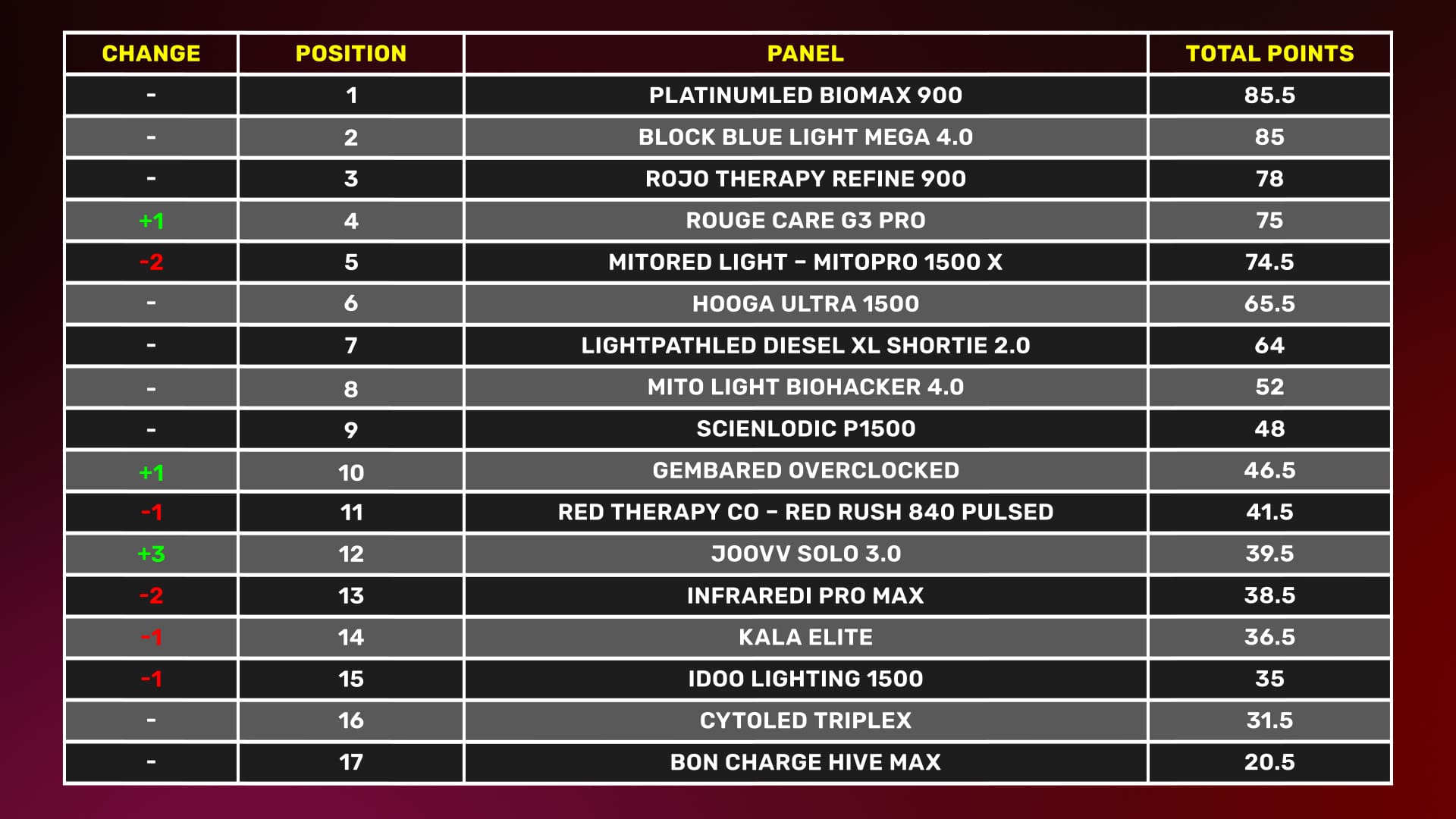
Ok, so if you look down the change colum, you notice that there aren't too many changes, especially in the top eight or nine panels. Rouge have jumped up one spot.
Another fun factor is that after six rounds, Rojo therapy have actually been the top scorers on three of those rounds. No other panel has won that many rounds. PlatinumLED won two of them, Block Blue Light has one, Mito Red Light has also won two. So, yeah, Rojo Therapy on third place, putting on a good show!
PlatinumLED still have first place but only just. Block Blue Light are right on their tails. At third place we have Rojo Therapy, 7 points behind - still an opportunity to come out on top. Then, Rouge Care have jumped up one placing with 57.
Mito Red are just behind them at 5th place but they have fallen a little bit in that round which is disappointing but technically they could still come out on top but realistically they'll be happy settling with a top-3 placing at this point.
Further down the table we do see that the Joovv Solo did come up three places and the Infraredi Max Pro dropped two.
There's only one more round to go, why wait? Let's go:
Round 7: Price
And here we are, the very last round of my 2024 red light therapy comparison series.
- This round we look at price and shipping. But to make things a little bit easier, I looked at prices in USD and I looked at how much it would cost to get a panel to your door in America.
- Some of the companies do ship internationally, some of them don't. You want to know the best panel for your particular region? I will be doing a blog and video on that very soon.
- The prices I'm going to share are the discounted prices. Now I am affiliated with a lot of these companies and I've asked them to give you the best deal for you. So some of the prices you see are exclusive to this channel. Now, to take advantage of those discounted prices, you have to use the discount code - typically that's ALEX. Full details are down below in the "items mentioned" section or in our Shopping Tool. Or, for some panels, for instance PlatinumLED you'll have to order though a discount link. The discount will be applied automatically.
All right, let's get comparing:
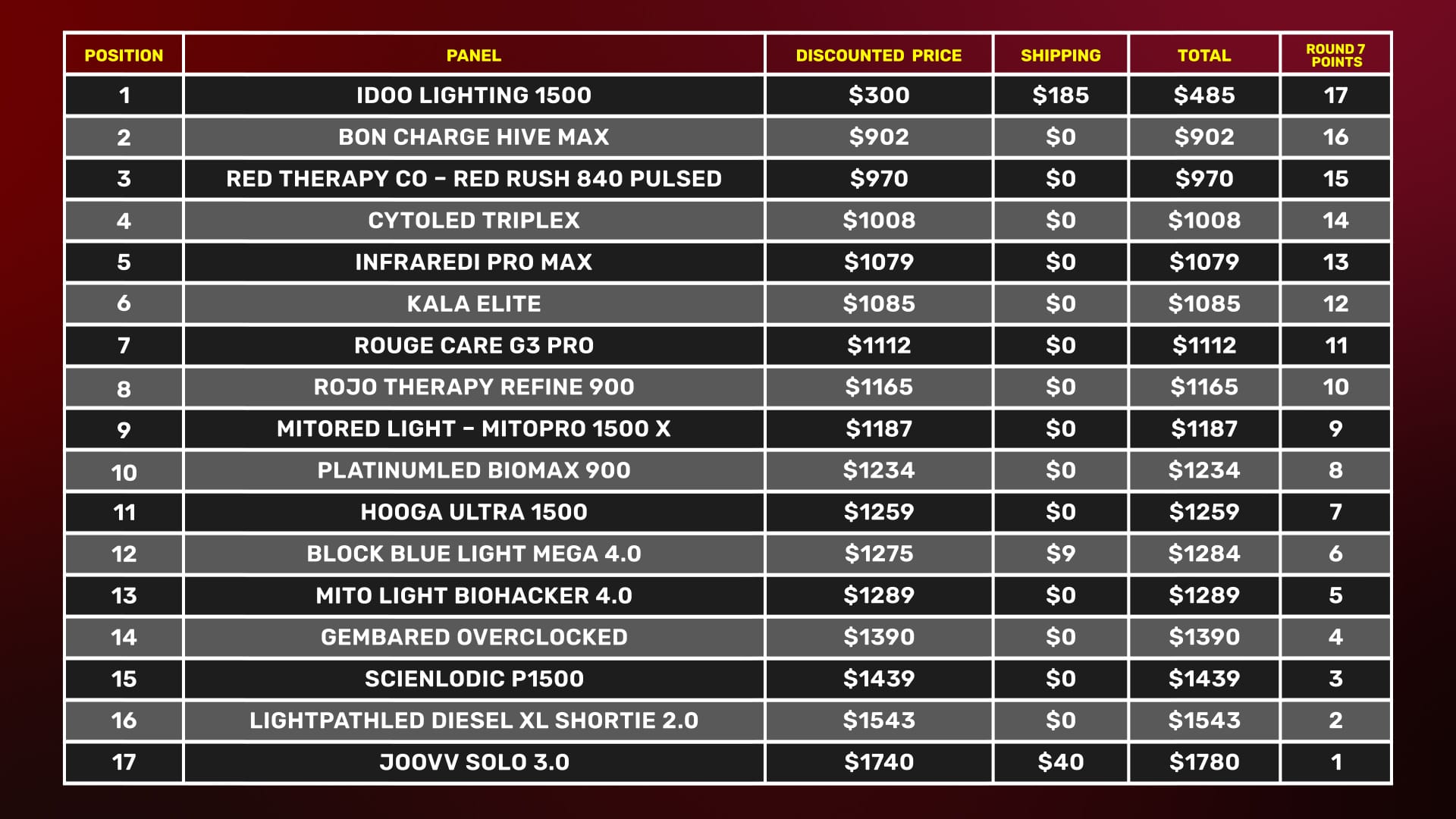
- So at the bottom of the table we have the Joovv Solo 3.0. $1,780 USD. It's a lot of money and it's really disappointing because their prices have just gone up despite the panel not really changing. And the other disappointing thing is that Joovv is placing really low on the overall standings. So it's not like you're spending big money for something super amazing.
- 16th place: LightpathLED. $1,543 USD.
- 15th place, the Scienlodic P1500.
- 14th place, the GembaRed Overclocked. $1,390 USD. I don't have a discount code for GembaRed
- 13th place, the Mito Light Biohacker.
- 12th place is the Block Blue Light Mega 4.0. $1,275 USD with a $9 USD shipping cost.
- At 11th place, the Hooga Ultra, $1,259 USD.
- 10th place, the PlatinumLED BioMax 900. $1,243 USD - when ordering through the discount link - and they don't have shipping costs which is great.
- 9th place, the Mito Red Light MitoPRO 1500 X - free shipping $1,187 USD.
- 8th place, Rojo Therapy Refine 900 - $1,165 USD.
- 7th place: Rouge Care at $1,112 USD.
- 6th place, Kala Elite, $1,085 USD.
- 5th place, Infraredi Pro Max, $1,079 USD.
- 4th place, CytoLED, $1,008 USD.
- 3rd place, Red Therapy Co Red Rush 840, $970 USD.
- 2nd place, BonCharge Hive Max, $902 USD.
- And then the 1st place was the Idoo Lighting 1500. The discounted price I got here was only $300 USD but I had to pay about $185 USD for shipping. So that brings the total up to about $485 USD - which is, really, really low. This price may have changed by the time this video has gone out. Remember, this is buying through the factory.
Now, before we do the total standings, I do need to share some insights here.
- The first thing I've noticed is that a lot of the panels have performed really well in this round are sitting really low on the scoreboard standings - pretty much saying: you get what you pay for! You pay bigger money, you get a better product. The exception being Joovv, which is the complete opposite of that, which is kind of crazy.
- The price is an interesting one as you want price in here because people are price consious. But at the same time, you may be happy to spend another $100 or $200 USD to get something that has a lot more power, a lot more bells and whistles, a lot more warranty, a better manual and that sort of thing. But price does need to be in here and that's why I left this to the end, so you can look at how the panel performs, before the score is influenced by price. Now I also need to mention I'll be doing a video on the best panel under $1,000 - it will be coming out soon.
Best Red Light Therapy Panels: 17th Place To Third Place
But it's time. Let's update the standings and we're going to go through the final results:
- All right, 17th place, we have the Bon Charge Hive Max with 36.5 points. Disappointing finish, but nothing has really changed with that panel over the years - so it doesn't surprise me.
- In 16th we have the Joovv Solo 3.0 - they dropped four positions after that price round. Honestly I don't really get it, they are super expensive. You are getting some nice things but they are just so far behind. Hopefully a 4th gen Joovv comes out soon and spices things up.
- 15th place, CytoLED
- 14th place, the Kala Elite, a disappointing as there was a lot of hype and marketing from Kala on their new Elite panel.
- 13th place, GembaRed Overclocked.
- 12th place, Scienlodic P1500.
- 11th place was Infraredi Pro Max. Yeah, another disappointing finish. Remember, these guys placed 3rd two years ago, so they've definitely dropped the ball here.
- 10th place is the Alibaba panel. That panel is up five positions purely on the price. If you take out price, remember, that panel was sitting at 15th place. Yes, you're getting good value but you're losing all other good features here.
- The 9th place the Red Therapy Co Red Rush 840
- In 8th place the Mito Light Biohacker 4.0. So, the first time this company has been in the series, they're finishing mid-pack. Honestly, I think their panel is really good, however, I do like their larger Mitohacker which has 400 LEDs but of course they wouldn't meet the criteria for this video. Check out that review HERE because it's actually a really good panel.
- 7th place was the LightpathLED Diesel XL shortie.
- 6th place Hooga Ultra 1500.
- Okay, so that leaves us with five. These are the top-5 red light therapy wall panels for 2024 as measured by yours truly.
- Ok, are you ready for this? 5th place goes to the Mito Red Light MitoPRO 1500 X. A somewhat disappointing finish given that they won last year. It's a great company with a great product - there's just a few minor things that cost them dearly. The narrower panel design is the big one - they're on the back foot from the first round. The panel does have some really good features, such as the touch screen control panel, the application is neat, great customer service, great energy blend. I mean, we're 5th out of 17, I mean, you're in the top portion here! You're getting great panels but we're looking for the best of the best. And this year, Mito Red didn't quite have it.
- In fourth place, and this may surprise a few people, was the Rouge Care G3 Pro. Now, the reason why it might surprise a lot of people is because it's not a well-known company. You may have not heard that much about it. However, their panel that was released in 2023 was one of the most powerful panels. They're a very credible company, they're sharing a lot of data, very good with the customer support as well. The downside was, they're only putting out 660nm and 850nm. In all honesty, for a panel to only have those two wavelengths, to finish in 4th place, it does show that they're doing a lot of things right. If they had a few more wavelengths in there, they would easily be in the top 3.
- Speaking of top-3, there are three to go. I'm about to reveal them all. Third place we have the Rojo Therapy Refine 900. Now this is an incredible result because Rojo Therapy were only founded I think in 2022. I don't like that and I mark the panel down because it is a new company, however, it is supported by Sun Stream saunas in Australia and I know they're a legit company and I know there's funding behind it and all those good things. But what excites me the most is that this company has come out with a panel that's innovative. Yes it's powerful, yes it has a good warranty, good packaging. But they've done something that no other company has done - they've built in smart modes. Not only that but they've built a panel that allows you to independently change the intensity of the wavelengths. Now, these both things I've been talking about for two or three years now and maybe even longer. And, no-one has done it, until Rojo came along and have done it, and it's very impressive and good on them as well. Not only that, but they're also selling their panel at a really good price. They were 8th place in that last round - a discounted price of $1,165 USD. That's really good for what you're getting. Plus you're getting that free stand as well, that's another $100-odd dollars that a lot of other companies charge. Congratulations Rojo Therapy - a newcomer to the scene, a second generation panel, third place, beating some big, big companies. Third out of 17 and you should be really proud and I think anyone that is going to use their panels is going to be very happy.
Best Red Light Therapy Panel 2024
So that leaves two. Two panels left: you know who the two are. We've got the PlatinumLED and the Block Blue Light Mega. Who is going to come out number one - I'm not going to announce second place...
What I'm going to do is announce the winner, and then we'll talk about second place later.
So the winner, of the 2024 red light therapy wall panel of the year, goes to...
Drumroll please...
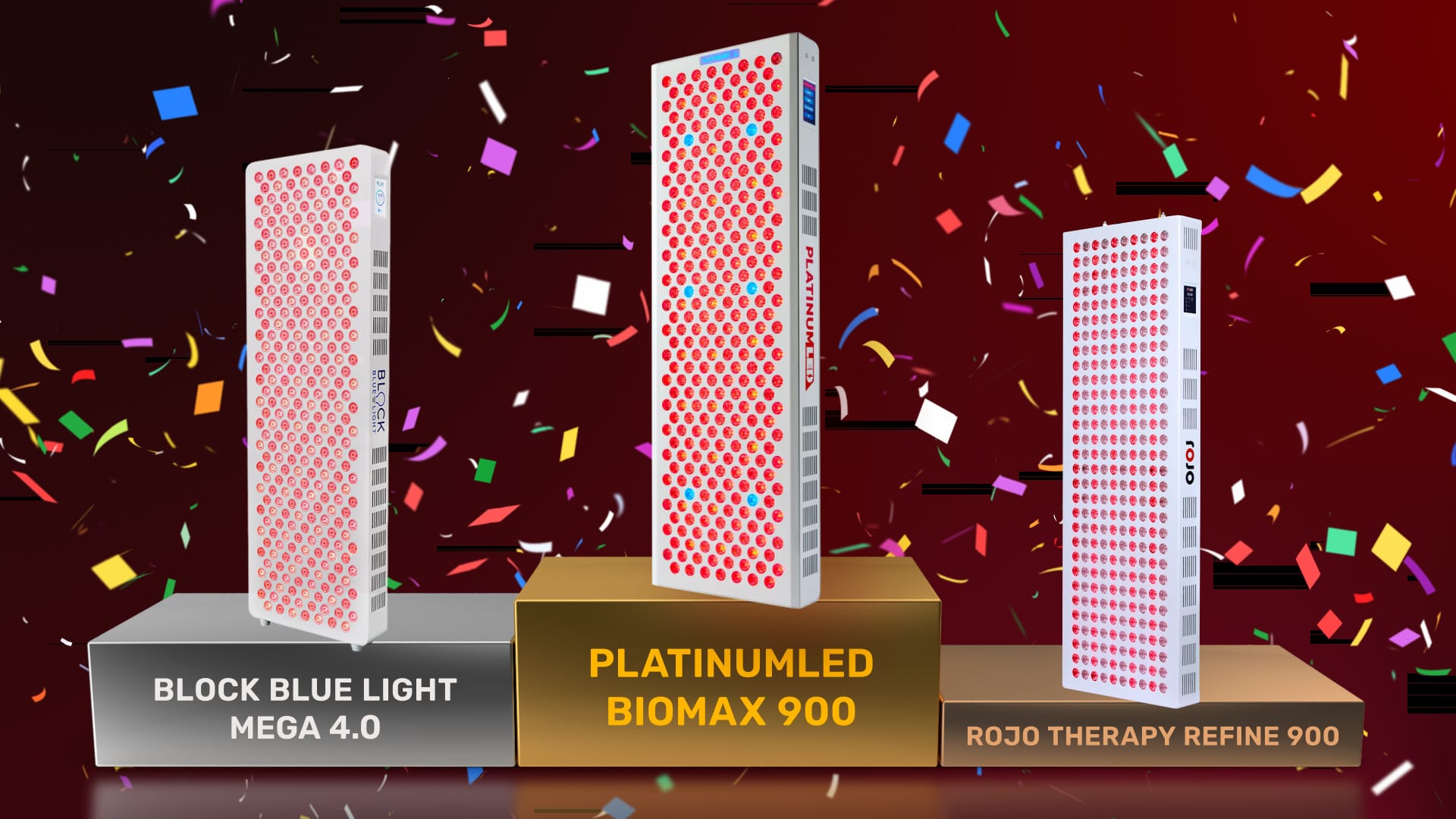
PlatinumLED BioMax 900!
This is a panel that won my very first red light therapy comparison series. They fell behind ever so slightly on the last one and they've stepped it up a notch. They've had two generation updates since that series and they've incorporated a lot of new features.
PlatinumLED have been well known to be very innovative, to put out panels that offer a ton of power, have great pricing and it's continued. They introduced blue light in their 7th gen and now in their 8th gen they added they 1,060nm near infrared light.
They have one of the best connectivity systems, you're getting a handy remote included, you get a really nice app that is just easy to use - it doesn't require signup or anything like that. You're getting great warranty, a great manual, there's heaps of stand options, honestly, I mean it is a really good panel.
So congratulations PlatinumLED. You've won the best red light therapy panel of 2024 (wall panel of the year) award!
Runner Up Best Red Light Therapy Panel 2024
But, of course, we need to talk about the second place. The second place was the Block Blue Light Mega Panel 4th gen.
Like Rojo Therapy, this is the first time they are included in my series. So we've got two newcomers that have entered to the top-3.
So Block Blue Light, this is their fourth generation panel. They put their fourth generation panel out just in time for this comparison series. And I'm glad they did because their new panel brought in the new touch-screen control panel, it brought in a better blend of light, it brougth in more power, and just a few other bells and whistles.
That just makes this a premium panel. It's a great size - all three of the top panels are the same size. 300 LEDs, really good pricing options, really good shipping options as well. It's another panel that I would be personally happy to use. And that's the key thing here. What's important to remember here is that all of the panels in this series are going to work - they are putting out therapeutic red light.
Even the Boncharge and the Joovv, they are going to work. It's just that these panels are better, they work better. Now, before you go out and buy, remember, I've reviewed all of these panels individually so you can go check out those reviews if you want to learn for a deeper dive.
I always recommend doing that because you get even more information than I can give in this comparison series. But, before you go, I want to do a few special awards below. Bear with me here and scroll down for the special awards!
(Also, here's the final scoreboard - I've put this at the end of the article to keep things very exciting!)
Round 7 Scoreboard (Final Rankings)
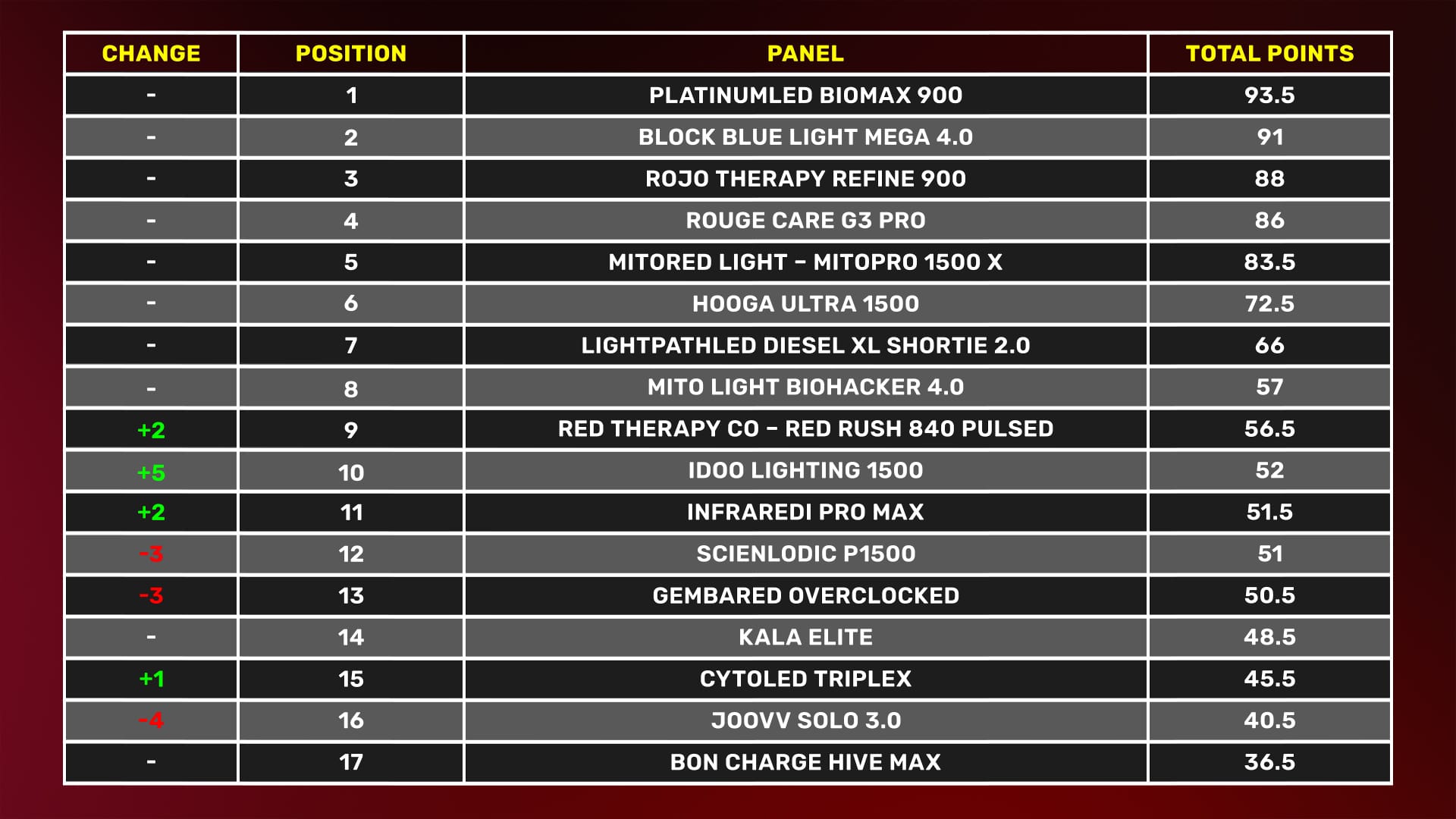
Special Awards Best Red Light Therapy Panel 2024
Below you'll find all the special awards of the best red light therapy panel 2024:
Newcomer Of The Year Award

The newcomer of the year award, well, it's a tossup between Block Blue Light and Rojo Therapy. I don't need to talk more about them - they are both great panels. So, take your pick!
Most Innovative Red Light Therapy Company

Most innovative feature, that goes to Rojo Therapy with their new smart mode and the ability to independently change the wavelengths. I think that's awesome so congrats to Rojo Therapy!
The Best Budget-Friendly Red Light Therapy Panel

This panel for those on a budget. You know, this is going to take me to long to score and report on so what I'm going to do is a separate video and blog on that! Be sure to subscribe to our YouTube to check that out.
Also, for you who are thinking "I live in Australia, what's the best panel?" - subscribe, there's videos coming out on that very soon!
The Most Disappointing Panel 2024
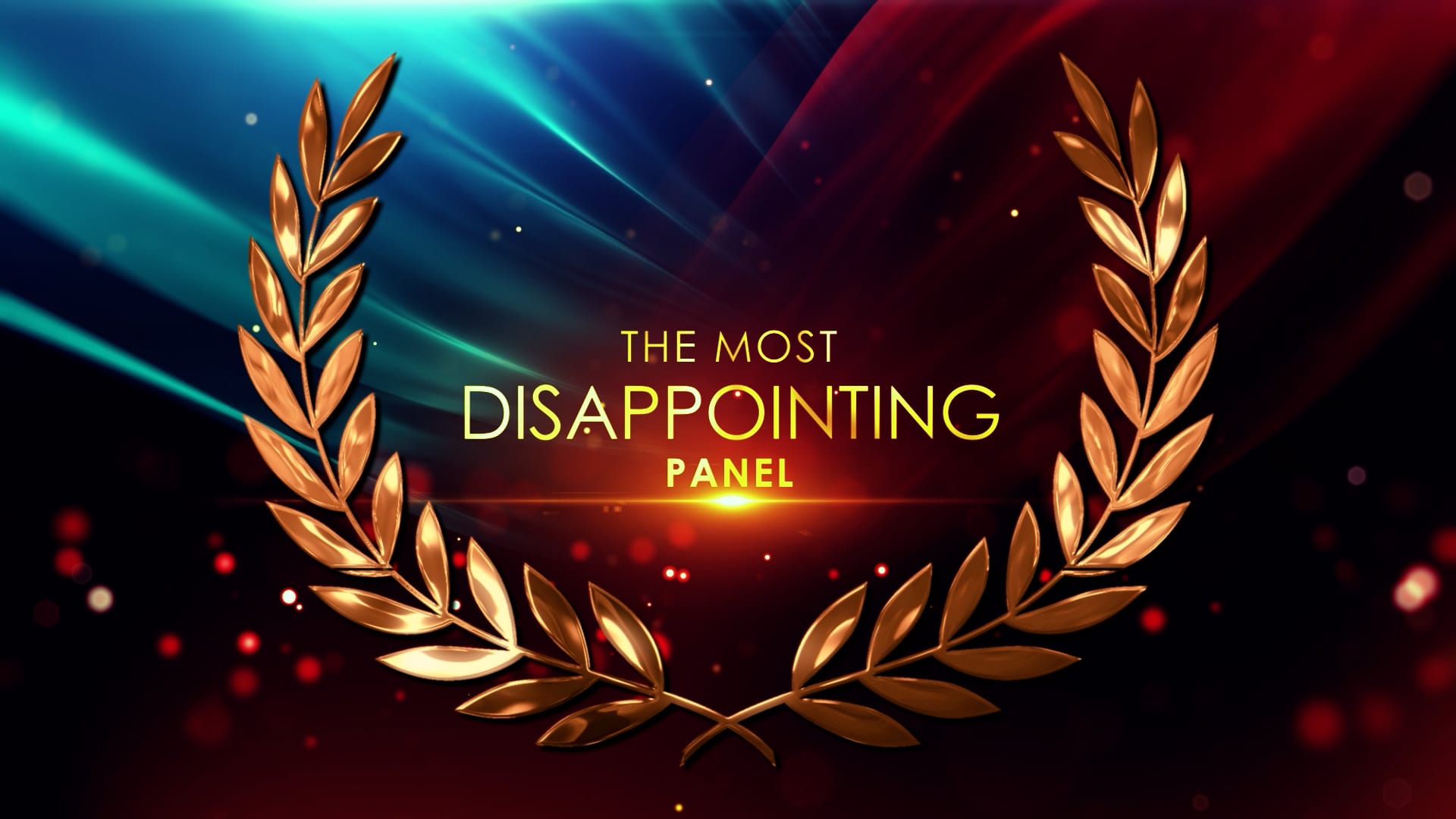
Finally, I want to talk about the most disappointing panel. Now, there's two here. Firstly we got Joovv, just because they've gone from being a market leader and doing really well in my comparison series to just falling behind. Not only that, falling behind on the features point of view but also very, very expensive.
So that is disappointing.
And secondly, the other disappointing panel would be the Infraredi. They placed third a couple of years ago and now they were below average. It's a shame and I think they really sort of stuffed up with their new panel.
But hey, they'll come back better, I'm sure!!
Extended Version Of Best Red Light Therapy Panel!?
Now, finally, I'll also be doing a deep dive, where I'm going through this in a lot more detail! I'll put that out in a separate video - as an extended cut and commentary video - and I also need to mention I'm open for criticism here. Not everyone is going to agree with this, but again, you can take the data and come up with your own conclusions!
Update:* Here's the 2024 extended cut of the best red light therapy panel comparison:
Now, here's a last reflection on why I made this extended cut:
The PlatinumLED BioMax panel is exceptional, however, it's not perfect, otherwise it would be a panel scoring top margin. But the BioMax didn't win every single round. BioMax, for instance, doesn't have the dual-chip LEDs, doesn't have the best blend of light and some people might want to see more power going to those other wavelengths. If that's a big problem for you then look down the list.
If it's not, then you know who to go buy from. Speaking of "buying from", discount codes and discount links are all listed below! But before you go out and buy, I recommend check out my dedicated review on the panel that you're looking at. Because I have reviewed all of these panels individually and I cover a lot more information in that review.
Items Mentioned
- PlatinumLED BioMax: https://aferg.co/redled - a unique discount code is generated after you click the link
- Block Blue Light Powerpanel Mega: https://aferg.co/BlockBlueLight - code ALEX saves
- Rojo Refine: https://aferg.co/rojo-rlt - code ALEX saves
- Rouge G3: https://aferg.co/rougecare - code ALEX saves
- Mito Red Light MitoPRO 1500 X: https://aferg.co/7d221 - code ALEX5 saves
- Hooga Ultra 1500: https://aferg.co/hooga-rlt - code ALEX saves
- LightPath LED Shortie XL: https://aferg.co/lightpathled - code ALEX saves
- Mito Light Biohacker 4.0: https://aferg.co/mitolight - code ALEX saves
- Red Light Therapy Co Red Rush 840: https://aferg.co/redrush - code ALEX saves
- Idoo 1500: https://www.alibaba.com/ - no discount available
- Infraredi Pro Max: https://aferg.co/infraredi - code ALEX saves
- Scienlodic P1500: https://aferg.co/scienlodic - code ALEX saves
- GembaRed Overclocked: https://aferg.co/gembared - no discount available
- Kala Elite: https://aferg.co/Kala - discount code is generated after you click the link
- CytoLED Triplex: https://aferg.co/cytoled - code ALEX saves
- Joovv Solo 3.0: https://aferg.co/joovvbca0 - no discount available
- BonCharge Hive Max: https://aferg.co/blublox - code ALEX saves



